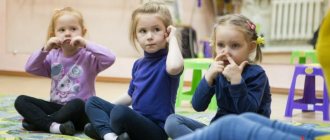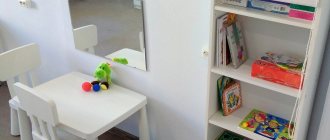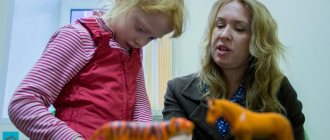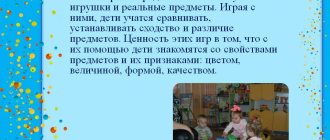From the first minutes of life, the baby finds himself in a society where there are certain rules, relationships, and forms of interaction. The main way of communication and transmission of information in human society is speech.
In a newborn, acquaintance with the outside world is built with the help of tactile sensations. But after 28 days, a healthy child hears sounds clearly. At 9-12 weeks, he tries to determine their source by turning his head and moving his eyes.
Involuntary “humming” and babbling gradually develop into a meaningful repetition of what was heard, the reproduction of individual sounds, syllables, and words. By the age of six, the development of coherent speech in preschoolers is an important criterion that determines their readiness for school, because it is not only a means of communication, but also a tool of thinking.
Thus, over about 6 years of his life, a child learns to compose connected semantic chains of sentences that help him, first of all, achieve mutual understanding with others.
What is “connected speech”?
An utterance or coherent speech is several complete segments (sentences) that are connected thematically, in meaning, and in structure. It serves to facilitate communication and is expressed in two forms:
- monologue - the ability to talk about a certain image, action, etc.;
- Dialogue is direct interaction with another person or people through communication.
Statements are the result of perception, comprehension, and the ability to express one’s thoughts. Coherent speech gives a clear understanding of the relationship between a child’s mental and speech development and helps solve problems in all areas of upbringing and education.
Monologue speech of older preschoolers consists of several main types:
- description - includes the general name of the object (action), a listing of its properties, qualities, and in conclusion - an assessment or attitude towards it (parts of this structure can be rearranged);
- narration is a statement of fact in which the beginning of the story, its culmination, outcome or denouement is clearly visible;
- reasoning is a separate type of statement that reflects a certain connection of events, facts, phenomena (consists of a statement, evidence, conclusion).
All these variants of coherent speech are found in children in a mixed form.
The initial and most important stage in the development of coherent speech in children is dialogue. It reveals the specifics of interaction, allows you to convey to the child the norms and rules for the further construction of monologue speech according to the laws of the literary language.
In order to correctly organize work on the formation of coherent speech in preschoolers, it is necessary to know the stages of its development, as well as to identify the main tasks for each type of speech separately.
Age criteria for the development of coherent speech in a child
Various patterns of communication and the gradual complication of a preschooler’s activities help the development of his thinking and speech.
Babies usually use their first meaningful words in the second year of life. Gradually they learn to designate an object with them, not by showing, but by naming. Next comes the grammatically correct formation of definitions.
A three-year-old child's vocabulary quickly grows, speech becomes more active, and sentences become more complex.
Related dialogic speech
To form joint objective actions, the child uses the first type of speech - dialogue (it is more associated with practical activities).
Until the age of three , children must be taught to voice their requests and desires (for example: “give”, “I want”, “go”), to give answers to simple questions (“who is this?”, “What is he like?”, etc.). Gradually lead to the manifestation of speech initiative (ask a question, turn to another person).
At the age of 3 to 4 years, a child should be encouraged to easily communicate with peers and adults; express requests in sentences; answer questions in phrases rather than in one or two words.
The child should be led to the point that he wants to follow simple rules of etiquette (say hello, thank him), share his impressions (what he did, what games he played); encourage the desire to be interested in life around and ask questions.
In the fifth year of life, children are taught to freely communicate with others of different ages, ask questions and answer them. You also need to support the desire to share personal observations and experiences. What is more important here is the quality of the answers, the ability to answer in accordance with the meaning of the question.
It is worth gradually involving the child in general conversations, where you need to be able to listen to others and express your own thoughts upon request or in turn. That is, the formation of cultural communication skills occurs.
In older preschool age, various types of cognitive and educational activities are held (games, activities, observations, excursions), which help improve previously acquired skills and abilities, consolidating and expanding knowledge.
Linked monologue speech
In parallel with dialogic speech, children are consistently taught to monologue. At different ages it occupies a certain place:
Before the age of 3, the prerequisites for the emergence of a monologue type of speech are laid.
Three-year-old children are taught to hear and perceive short, understandable stories and fairy tales. They offer to repeat individual phrases, briefly reproduce events, looking at the illustration.
It is necessary to purposefully develop monologue speech from the age of 4 . Children are asked to describe the toy, tell a familiar story using personal experience. Hints like: “Once upon a time...”, “...and they went...”, “he met...” - enable the child to compose related narrative statements, which become more complex and increase in volume over time. Specially simulated situations and individual communication help you to independently talk about your toys, events that have happened, etc.
From the age of four, children retell not only frequently heard stories (fairy tales, short stories), but also new, newly read stories. Descriptive stories become detailed, structured, with elements of special forms of storytelling. For example, “one day...” or “one day...”.
Adults help start the story, offer to describe in more detail the character, location, etc. A series of pictures can be a good help for creating a coherent, structured story. At the same time, at 5-6 years old, preschoolers can already operate with phrases such as “while...”, “and now, after that...”.
With systematic lessons, children quickly learn not only to compose narrative and descriptive stories using pictures (toys), but also to do without visual materials.
In the development of connected monologue speech, the most important factor is training, in dialogic speech it is the direct interaction of two or more people. And here the main methods are everyday communication, play activities, completing tasks, and joint activities. Only the painstaking, daily work of adults gives excellent results in the development of coherent speech in children.
Reasons for the delay in the formation of coherent speech in children
To determine the level of development of coherent speech, you need to analyze compliance with the age criteria listed above, that is, make a kind of diagnosis. It should be carried out in a playful way, without focusing the child’s attention on the result, without making comments, without correcting, without teaching. Just create a situation and observe the behavior and speech of a preschooler.
Difficulties and difficulties in speech development can occur in children for medical reasons:
- pathology of intrauterine development (mother's exposure to infectious diseases, intense toxicosis);
- birth injuries (asphyxia, premature birth, infection, etc.);
- childhood head trauma, especially in the area of speech zones;
- hearing or speech impairment (the latter is diagnosed by age 5).
There are also social reasons that slow down the development of coherent speech in a child:
- pedagogical neglect - they do not work with the child or the child exhibits behavioral disorders (“difficult child”);
- lack of communication in a family - the lack of direct, close communication between all its members, when several people simply exist under one roof;
- change of place of residence, especially in a foreign-language environment - if at home they speak one language, in a child care center and on the street - in another, the child experiences difficulties in mastering speech skills.
Excessive care can also lead to speech delays, since the child simply does not need to speak if his wishes are guessed and instantly fulfilled.
As a rule, by the age of 5-6 years a child can:
- consistently answer questions;
- compose short narratives based on illustrations;
- describe your impressions of what you saw;
- convey the content of what was heard or seen from memory;
- come up with a continuation of a fairy tale, fantasize.
But in order for the result to meet age requirements, it is necessary to pay enough attention to communication and activities with the child at each stage of growing up.
“Write a story” (for children 5-6 years old)
Each participant in the game receives a large card (based on the lotto principle), consisting of 8 pictures separated from each other by lines. They are located two in one row. The last picture of the previous row corresponds to the first picture of the next row. Children are also given a set of exactly the same individual (cut) pictures.
The teacher reads:
The cat loved sausages. The sausages were in the bag. The bag was guarded by a dog. The dog prevented the cat from stealing the sausages.
At first, children listen to the story based on a large card, then it is turned over, and the players “write down” the story using separate cut pictures, arranging them in the following order:
cat-sausages sausages-bag bag-dog dog-cat
Next, the players take turns telling, based on their plan, what they did. Then they discuss with the teacher whose story is more accurate. When children have mastered the principle of “recording,” they can listen to the next story without relying on a large card and try to “record” it immediately with separate pictures.
For example:
Sonya was eating candy. The dog smelled the candy. The dog opened the cupboard. There were sweets in the buffet.
Another version of this game can be a story invented by the child himself. He is asked to look at a large picture, the child “strings” one sentence onto another, covering its analogue on a large card with a separate picture. I use this game in subgroup classes, when two or three people can play at the same time.
Ways to develop coherent speech in preschool children
Methods and techniques used in working with children to develop coherent speech are divided into:
- visual - using demonstration material, illustrations, living objects, objects, diagrams;
- verbal - reading, storytelling, conversations, retellings, memorizing poems, performing speech exercises, pronunciation, etc.;
- practical - role-playing, didactic games and exercises (with speech content), theatrical performances, surprise moments, characters, round dances.
Depending on the age of the child and the degree of his individual development, a set of means is used that promote the development of coherent speech.
So, for the little ones , where words are combined with actions (“Ladushki”, “Magpie”, etc.).
For older kids, you can offer exercises for imitation and development of the articulatory apparatus. Here we can use various demonstration materials, preferably voluminous and natural in color. For example, the nursery rhyme “Cockerel, golden comb cockerel...” together with the corresponding toy, will help the baby visually become familiar with the object and try to repeat its “song.”
Children's works by Agnia Barto, S. Ya. Marshak, E. Charushin and other authors are classics of fiction that create images with additional emotional coloring of the characters. The same can be said about fairy tales (“Turnip”, “Ryaba Hen”, etc.)
Practical exercises that develop speech breathing (“blow off a snowflake”, “fly a butterfly”) can also be used to develop coherent speech at an early age.
As the baby grows, practical methods are most effective. And since play is the main activity of a child, it is perfectly used in practice (for example, “Telephone”, “Whose house?”)
Younger preschoolers enjoy playing children's outdoor games, accompanied by the words: “Bubble”, “Carousel” and others.
To activate your brain, you should use your fine motor skills. Modeling, drawing, and working with construction kits help to form images and contribute to the development of a child’s speech.
The older the child, the wider the opportunities for activating his speech. It is important to properly organize and direct the educational process. In this case, it is necessary to take into account the individual psychological characteristics of the child.
Main conclusions
By the end of preschool age, children should master the skills of coherent speech. The development of all aspects of coherent speech should be stimulated by various methods, using role-playing games, theatrical activities, speech sets of cards, didactic games for the development of logic, consistency and expressiveness, and mnemonics.
With regular use of these techniques, the child’s speech during the examination before entering first grade will be at a high level. Speech develops most quickly in play, the leading activity of preschool children.
If you liked the article, please share a link to it










